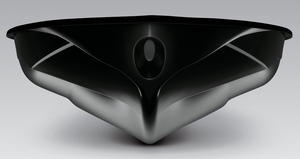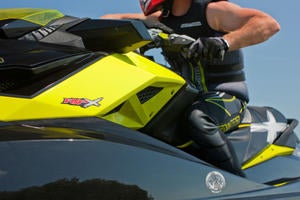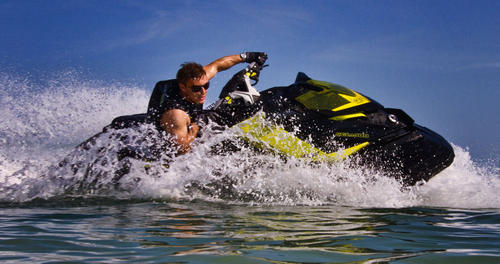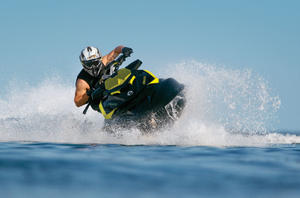2013 Sea-Doo RXP-X 260 Review
It's fast, it's furious...it's fun
Sea-Doo’s RXP-X 260 proved a lot in its inaugural season, not the least of which is that performance-minded, two-seater personal watercraft are far from extinct. True, the market is dominated by larger craft. In many cases, they make more sense, able to do more, haul more, and arguably handle more than a pipsqueak two-seater. But hey, sometimes you’ve just got to be a little selfish.
A craft like the RXP-X gives you good reason to do just that.
All About Handling
 The new T-shaped hull gives the RXP-X more nimble handling manners.
The new T-shaped hull gives the RXP-X more nimble handling manners.Sea-Doo designers and engineers obviously put a lot of time into the RXP-X, and the effort shows in details large and small. One obvious biggie is the hull. A completely new design for Sea-Doo, it sports a noticeable T-like shape when viewed from behind, a visual produced by a center running pad that abruptly drops below the hull’s lines as the viewer’s eyes move toward the keel. The idea behind that lowered pad is to allow the boat to run on a reduced running surface when at higher speeds, essentially giving it the feel of a smaller, highly nimble craft. The outer portions of the hull – the horizontal portion of the letter T – aid in cornering. They feature soft, rounded chines which allow the boat to really lean over and roll into a turn, and help keep it there once that turn is underway.
 Adjustable sponsons can help alter the craft’s attitude in the corners.
Adjustable sponsons can help alter the craft’s attitude in the corners.Sponsons enhance the hull’s performance. On the RXP-X, a small, horizontal winglet is added near each sponson’s trailing edge. The reason? In sharp turns, a vertical sponson’s effect is reduced as the boat’s lean positions the sponson more toward the horizontal. Similar to the same idea being used on slalom water skis for decades, the 90-degree winglet adds grip in this situation, helping to initiate the turn but then helping keep the boat planted and preventing chine walk as the hull is leaned farther into the corner. The vertical position of the sponsons is user-adjustable; they can be lowered at the tail for more bite in the corners, or raised for a more forgiving attitude.
The other hull additions are aftermarket-like trim tabs. They help keep the bow lower during acceleration as well as in rough water conditions, provide some degree of straight-line stability, and improve top-end speed.
Staying In Control
 A sculpted saddle gives the rider more control over the craft.
A sculpted saddle gives the rider more control over the craft.As I noted last year, those hull characteristics combine to produce one of the most aggressive handling PWC on the market. And such aggressive handling below means something needs to be addressed above to help the rider handle the resulting force. Here, Sea-Doo took a close look at how the rider interacts with the craft, and how the boat’s design could alleviate some of the stresses while enhancing the rider’s overall control.
The solution is dubbed “Ergo-lock,” and it consists of a rethinking of the traditional rider ergonomics. Rather than wide (typically to compensate for the engine below), the Ergolock saddle is sculpted into an hourglass shape. It’s thin midsection enables the rider’s knees to be much closer together, rather than spread apart. Atop the knees and lower thighs, generously padded bolsters extend to provide additional leverage and security. The result is the rider is now able to use their much stronger leg muscles, rather than the weaker arms and upper body, to stay atop the craft in an aggressive turn. Further aiding the riders’ leverage over the craft are canted footwells, which angle inward to give the foot something to press against. Add handlebars which can be tweaked to rider preference, and a hull that naturally leans to the inside, and you’ve got a commanding position that is far less tiring on the body.
All About The Ride
With such an emphasis on handling and ergonomics, it’s easy to overlook the engine that is pushing the hull to such limits. As you might expect, it’s the familiar 1,494cc Rotax 4-TEC, packaged with both a supercharger and intercooler to boost its performance. It pushes the craft to a top speed of 67 mph with a light load; that same engine also propels the boat to 30 mph in just under two seconds.
As previously mentioned, with a rider that is skilled and ready for what is to come, turns can be entered at the higher ends of that speed range. And exited. Rather than bog down, slide, or exert so much centrifugal force the rider is at risk of being unceremoniously high-sided off the craft, the RXP-X responds well to the rider’s input. A high-performance, electric trim further fine-tunes the craft’s response, lowering the bow in the turns or when accelerating, and raising it for best top speed.

Advice? Put your ego aside on this one, and progressively work up in terms of both speed and sharpness of cornering. Given the exceptional feeling of control, riders may be tempted to push their limits before they’re ready.
As with any performance craft, there are tradeoffs. Given the mindset of the performance customer, I tend to think a more accurate description is acceptances. That agile hull can produce the occasional surprise. Most notable for me was a tendency to roll to one side when abruptly slowing and coming off the center pad. As well, the preset position of those thigh bolsters doesn’t always accommodate taller or shorter riders; shorter riders may find the support is not always there, while taller riders may be forced to sit farther back on the saddle to find the necessary room. On the positive side, although I prefer the boat in calmer conditions, I find the hull to be fairly adept at rough-water handling. It’s certainly a notch above the previous RXP-X.
More, More, More…
There’s a lot going on with the RXP-X, and consequently a lot that gets left out of the average-sized review. Thus far, I’ve said nothing of the style. It’s reminiscent of the GTI, with abrupt angles that nonetheless flow from bow to stern. Colors are aggressive (black and neon yellow), while the handlebars sport a billet, aftermarket appearance. Stowage, mostly found below the forward hatch, is an impressive 30.8 gallons.
The RXP-X also features Sea-Doo’s Intelligent Brake and Reverse (iBR). The system adds a brake lever to the left handlebar; squeeze it and a bucket deploys over the pump’s thrust, redirecting it forward and to the sides to dramatically slow forward speed. That same setup also allows for a very intuitive reverse, and even a “neutral” mode. You can easily start this craft up at the dock in a stationary position, and then shift it into forward or reverse as required. It’s great in tight confines. Electronic throttle also gives you user-selected acceleration profiles. Go all-out aggressive, tame the response for newcomers or casual riding, even tell the computer to choose the profile that will produce the most fuel-efficient results. The Learning Key lanyard further fine-tunes that response, allowing the owner to choose a digitally encoded lanyard that limits the engine’s potential even further.
The lasting impression, however, is not of what this boat has, but what it does. And trust me, you’re going to want to experience that for yourself.
| 2013 Sea-Doo RXP-X 260 Review Specs | |
| Length | 130.6 inches |
| Beam | 48.3 inches |
| Dry Weight | 812 lbs |
| Engine | Three-cylinder EFI, Supercharged/Intercooled |
| Displacement | 1,494 cc |
| Bore and Stroke | 100 mm x 63.4 mm |
| Compression Ratio | 8.4:1 |
| Rated Horsepower | NA |
| Fuel Capacity | 15.9 gal. |
| Combined Stowage Capacity | 30.8 gal. |
| Colors | Dayglow Yellow |
| Price | $14,699 |
Related Reading
2013 Sea-Doo Lineup Preview
2012 Sea-Doo RXT-X 260 Review
2013 Sea-Doo GTI SE 130 Review
Get PersonalWatercraft.com in your Inbox!
Like PersonalWatercraft.com on Facebook
Comments
Most Popular

Remembering the Sea-Doo XP

2025 Yamaha JetBlaster PRO 2-Up Review

2024 Yamaha GP HO Review

2024 Kawasaki Jet Ski STX 160X Review

2017 Kawasaki Jet Ski Ultra 310LX Review
















 Your Privacy Choices
Your Privacy Choices